Want to just get started? Click here to sign up for Hostinger and create a website today.
You can create a website in less than 20 minutes. You don’t need to be a tech wizard either.
It doesn’t matter if it’s for business or pleasure. You don’t need a fancy designer or an expensive developer. Just follow the simple steps below and you’ll be online in no time at all.
Quick Start Checklist To Create A Website
Want to just get your website running as quickly as possible? Follow these two steps to get your own piece of internet real estate up and running in 15 minutes or less.
1. Sign up for Hostinger. Select their Premium Shared Web Hosting plan for just $2.99 per month. It’s an amazing deal and you get a free domain name, too. Follow the steps to create an account and purchase the plan.
- Best deal for hosting
- AI website builder
- Free domain registration
- Starts at $2.99/month
2. Install WordPress. 43% of the web is built on WordPress, and you can install WordPress as your content management system (CMS) with just one click from your Hostinger control panel. You’ll use your CMS to control the look and feel of your website. It’s also how you’ll upload all your content.
Voila! In less time it takes to watch an episode of your favorite show on Netflix, you can have your new website live.
If you want to create a website that builds an audience and makes you money the right way, there is a bit more to do. But don’t worry! Everything you need to know is covered in the rest of this post.
8 Steps to Create a Website
Here’s a summary of the steps to build your website:
- Choose the perfect domain
- Get web hosting and free domain registration with Hostinger
- Claim your free domain with Hostinger
- Install WordPress with Hostinger
- Design your website with a customizable theme
- Build your website’s architecture
- Connect your web pages with menus
Feel free to use these links to jump around to the section you need as you create your website.
Step 1: Choose the Perfect Domain
Choosing a domain is the most important decision you can make for your site. It literally says how you want to be represented to the world. It’s the address for your site and the way people will remember who you are.
While many of the best domains are taken, that doesn’t mean you won’t be able to find a perfect domain for your brand.
When brainstorming good domain names, consider the following elements:
- Easy to say and spell. Potential visitors should be able to say your domain name out loud to someone without them having to ask twice how to spell or say it.
- Short and sweet. We recommend no more than 14 characters. You don’t want an overly long domain name that’s hard to remember and say.
- Go with .com, .org, or .net. While there are plenty of domain name systems out there, it’s best to stick with the tried-and-true. You want people to be able to remember it, after all.
- Use your name. A particularly great choice for a personal blog, website, or portfolio.
- Avoid numbers and hyphens. This just makes it look weird in the URL. Plus it makes it harder for people to say your URL to others.
Come up with a few potential domain names in case your top choice is already taken. Hostinger’s Domain Name Search is free, and it will let you know if the domain name you want is available.
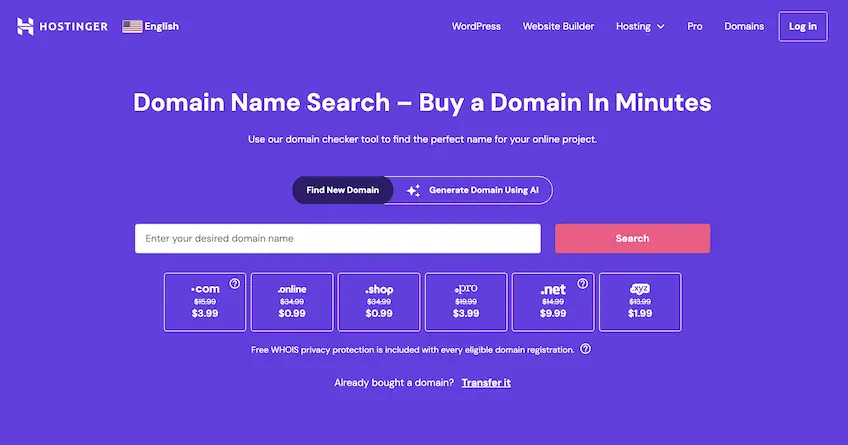
Type your desired name into the search bar. If it’s available, fantastic. If not, Hostinger will automatically provide a few recommendations that are close to what you are looking for.
Maybe one of the recommendations works for you. Maybe you have to try a different approach.
We recommend you brainstorm ideas and search until you find an available domain you like, rather than taking something that isn’t quite right just because it is available. If you get stuck, you can always try one of many other free domain name generators to kickstart your creative flow.
It’s possible to buy a domain that’s already taken—but we don’t recommend doing that because it’s very expensive. In fact, quality domains typically cost a few thousand dollars at a minimum. They can even go as high as six or seven figures for a domain.
Our advice is to get scrappy, get creative, and be flexible. You will be able to find one that’s available at a reasonable price.
Don’t add the domain to your cart at this time–you can get a domain for free by signing up for their Premium Shared Hosting service, which is what we recommend.
We’ll walk you through that process next.
Step 2: Get Web Hosting and Free Domain Registration With Hostinger
A website needs just two things to go live: A domain name and a web host.
You just came up with your domain name. Now it’s time to put it to use with a good web host.
We highly recommend you use Hostinger for your website’s host. They offer fast and reliable web hosting. Hostinger also allows you to register your domain free of charge.
- Best deal for hosting
- AI website builder
- Free domain registration
- Starts at $2.99/month
You can get Hostinger today for just $2.99/month using our discount link. It’ll give you all you need to get your website up and running.
Head over to Hostinger’s website to claim your deal.
Navigate to the Hosting menu and select Web Hosting from the drop-down list.
Hostinger offers three different options that are suitable for beginners—Premium, Business, and Cloud Startup.
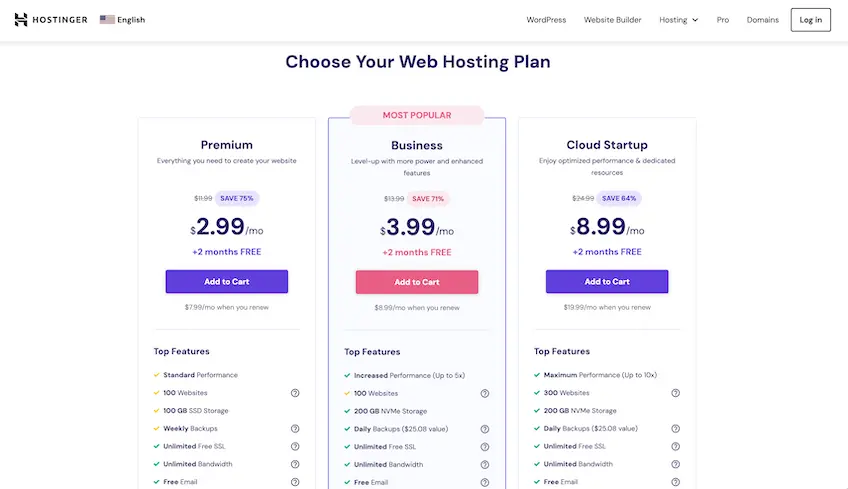
The Premium plan is fine for most beginners. But if you’re planning to sell products or services online through an ecommerce site, go with the Business or Cloud Startup plans. These are better for high-traffic sites, and come with extra storage.
You can’t really go wrong with Premium if you’re just starting out, and you can always upgrade down the road as your needs change.
$2.99 per month is phenomenal price, especially when you consider that many other hosting providers charge extra for things like SSL certificates, website builders, and other critical features that Hostinger bundles in for free.
After selecting the length of your hosting agreement, complete the rest of the information on the page.
- Register an account with Hostinger. You need to provide a valid email address that you check regularly, as this is how Hostinger will communicate with you about any issues that come up.
- Enter payment details. Hostinger accepts all major credit cards. You can also pay through PayPal, Google Pay, AliPay, and Coingate.
- Click “Submit”. Once you submit your payment, you have 30 days to try Hostinger risk-free. If you are not happy with your service, cancel within the first month for a refund.
Once your payment goes through, and you confirm your email address, you’ll be able to begin setting up your site.
Other web hosts offer similar promotions, but Hostinger is definitely our top pick. You can check out our complete Hostinger review to learn more about this provider.
If you need managed WordPress hosting, WPEngine is a fantastic option. As a managed host, WP Engine professionally maintains speed and security at the server level, so you don’t have to do anything.
For more hosting options, you can read our full reviews of the best web hosting providers here.
Step 3: Claim Your Free Domain
If you sign up for Hostinger’s Premium or Business hosting plan with a minimum 12-month commitment, you’ll get a free domain with your hosting subscription.
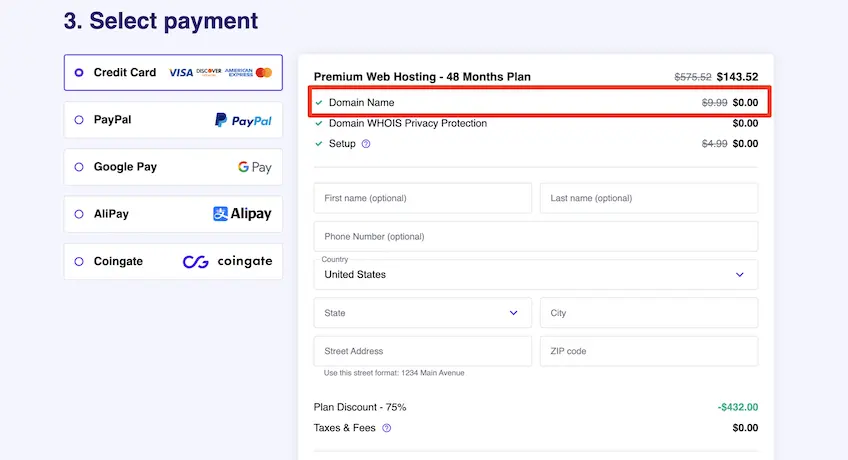
Your domain is only free for one year, and it will automatically renew at a higher rate. This is common practice for every web hosting provider that offers free domains.
Just keep an eye on the renewal price as you’re completing this step to avoid any surprises down the road.
If you’re connecting an existing domain and want to change the domain name to something new, now is a good time to do that, too.
Step 4: Install WordPress with Hostinger
Now it’s time to choose your CMS (content management system), and WordPress is our top recommendation.
You’ll have other options to choose from through Hostinger. But unless you have a niche-specific reason to do so, WordPress is the best option for the vast majority of new websites. It’s simple, affordable, and gives you complete control over your site creation.
To install WordPress, go to your Hostinger account management dashboard and click the Websites menu on the top of the screen. Then click Manage. Scroll to the Auto Installer and click Select below WordPress.
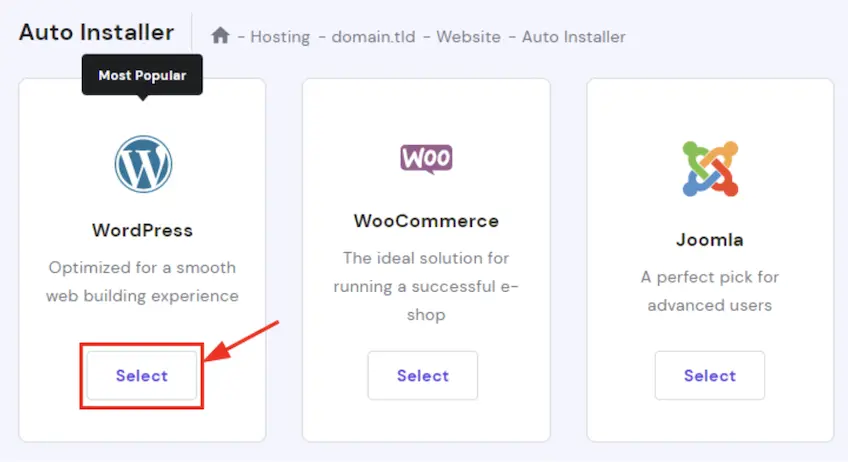
Then it’s just a matter of following the prompts on the screen. You’ll be asked to name your site and create new login credentials for WordPress. This is separate from your Hostinger login.
Once installed, it’s time to select a theme.
The theme is essentially the layout of your site—controlling the way it looks and feels.
Don’t overthink this too much right now. You can always change your theme and customize the layout later on. We’ll cover those steps in greater detail shortly.
But for now, just confirm that your information is correct to proceed.
Double-check everything closely to confirm everything looks right. The setup process will take about five minutes to complete.
Congrats! You now own a piece of the internet!
Step 5: Design Your Website with Customizable Themes
You already selected a WordPress theme to build your site, and if you are happy with the way it looks, great!
If you want to see what else is out there, you can explore tens of thousands of themes on WordPress.org. A lot of them are free. There are also some you need to pay for.
Pro tip: Don’t worry too much about this section. It’s easy to get caught up with perfectionism and think that you need to get your theme right the first time. That’s not true.
The most important thing you can do is choose a basic theme and go with it. You can always change your theme later.
Go to your WordPress website’s administration dashboard. You can do this through Hostinger, or you can use the URL [your website name].com/wp-admin. Then simply use the username and password you got in the previous step.
Once you’re in the admin dashboard, go to your sidebar and click Appearance>Themes>Add New Theme.
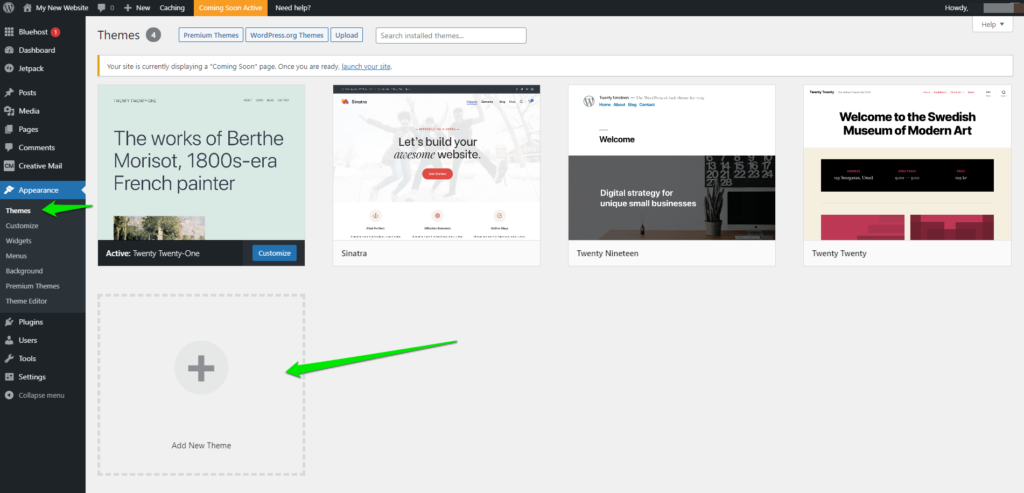
This will allow you to add any theme you want from WordPress’s library. Choose one now.
For this article, we’ll be using OceanWP. This is a free theme that’s very flexible. Whether you need a blog, ecommerce store, or whatever else, OceanWP can get it done.
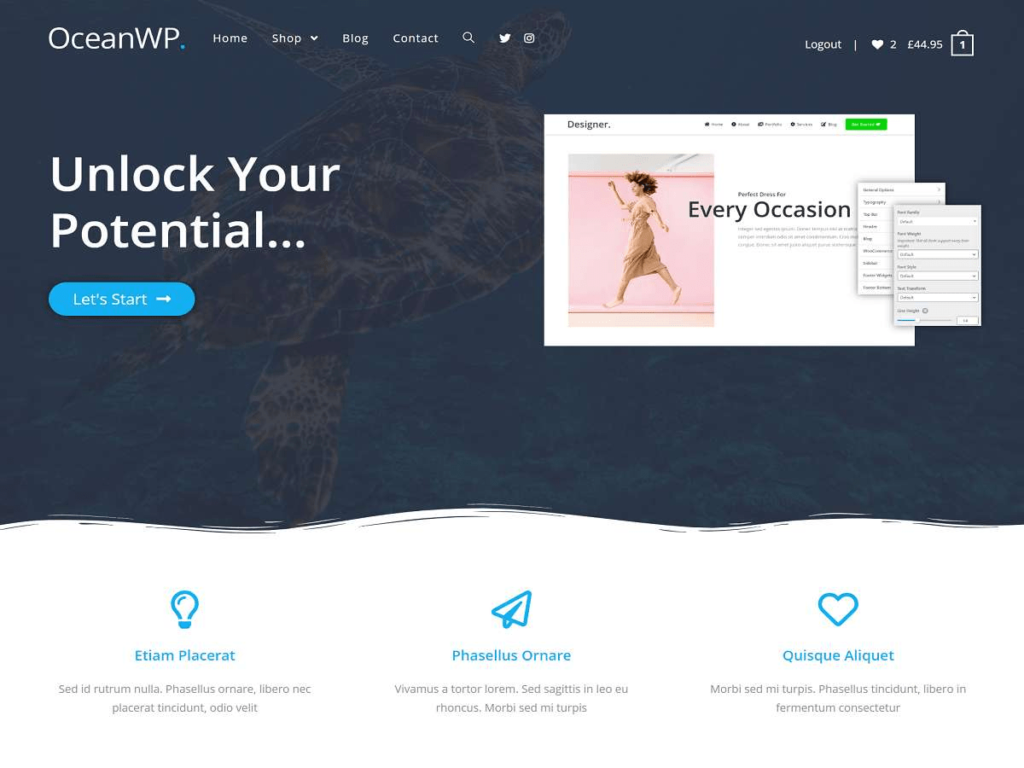
Search for the theme using the search bar. Once you find it, click Install.

Once it’s finished installing, click on the Activate button. This will implement the theme onto your website.

You can now customize the theme to your liking by clicking on the Customize button.

You’ll now be able to change any aspect of your website you want. This includes things like your website’s colors, menu options, header images, and more.
After clicking on customize, you’ll see a look at your website as you customize it as well as a left sidebar with different customization options.
Each theme offers different options, but there’s a lot of overlap between themes. We’re going to go into more detail about what each option does—and whether or not it’s vital:
- Site Identity. Important. This area will allow you to change your site’s title as well as a sub-head or tagline. In most instances, you’ll also be able to upload a site icon as well. This is the image that appears in new browser tabs when people are on your website.
- Colors. Optional. Change your website’s color palette. For OceanWP, this section only allows you to change the color of the title text.
- Menus. Very important. It allows you to create a navigation menu for your website. Your reader will use this menu to discover and navigate to specific pages of your website. You’ll also be able to choose where the menu appears (e.g. top, footer, sidebar).
- Widgets. Optional. These are different tools you can place throughout your website such as archives, calendars, search bars, and more. Completely optional, but can be helpful depending on what website you have.

- Homepage Settings. Optional. This controls whether or not you have a static homepage, or if your website automatically shows your latest blog posts. Again, this is completely optional and dependent on your website’s needs.
- Additional CSS. Optional. This is where you can add further customization options using CSS code. This can be incredibly powerful if you have the right resources and knowledge to change your website.
- General Options. Important. This section allows you to customize a ton of different aspects of your website. It includes things like the size of your header, the icons you can use, the titles of your pages, the layouts, and more.

- Typography. Important. This is where you can customize all things font related. That includes the size of the font, what type of font you want to use, and where those fonts will appear. For example, you might want to go with Helvetica for your H2 headers, but you might want to go with Comic Sans for your title (please, don’t actually do this; it is just an example).
- Top Bar. Optional. This edits the top area of your website. You can add social links here, buttons to other pages, and more.
- Header. Important. Allows you to fully customize the header area of your website. Add images or logos, change the font and colors, or whatever else you want to do to make the website yours.
- Blog. Optional. This allows you to change the layout of your blog as well as which posts appear on your website’s main page.
- Sidebar. Optional. You can add a sidebar to your website. This is completely optional since your readers can just use the top navigation bar to get around your site.
- Footer widgets. Optional. Add tools and customize your footer.
- Footer Bottom. Optional. This is the part of the website with the copyright and contact information. It’s potentially important–especially if you’re running a business.
Now, customize your website to your heart’s desire. Once you’re finished, click Publish, and voila! Your website will update automatically to reflect your changes.
Your website’s still going to look a little sparse. We need to create some pages for it.
Step 6: Build Your Website’s Architecture
If your website is a house, it’s currently an empty lot. It has a solid foundation and it’s connected to essential utilities—but it needs the walls and rooms.
To build those, you need to create web pages. These are documents on the internet that readers access through your website.
But you should think of them as the rooms of your house. These are the areas visitors will see and get to know you and your website.
While there are a lot of different types of web pages that exist, the most essential ones are:
- Homepage. This is the main page for your website. It’s what readers see first, so it’s very important.
- Contact page. This page shows how your users can contact you. This can be vitally important, depending on your business.
- About page. This page tells new visitors all about your website and/or business. Typically, businesses will put their “brand story” here about how they came to be.
- Online store. This is where your readers can purchase products and services from you. An online store can also be vitally important depending on your business.
- Blog page. Blog page. This page is where all of your blog posts go. If you plan on publishing articles for readers to read (which you should—61% of buyers make purchase decisions based on blog content), this will be a very important part of your website.
Creating pages on WordPress just takes a few clicks. Let’s jump into how you can create the most important page now for your website.
How to Create a Homepage
OceanWP gives you two different ways to create a homepage:
- Your latest posts. Your homepage showcases your latest blog posts.
- A static page. You create a page to become your home page.
The first option is straightforward: Create blog posts and the homepage will automatically show all your latest blog posts.
That’s why we want to walk you through creating a static page for your website. This can be especially useful for companies that just want a branded page to introduce their audience to the website.
It’s also much more customizable than a page showing your latest blog posts.
First, head back to your WordPress website dashboard and click on Pages>Add New.

Now, you’ll be in WordPress’s page editor mode. This area allows you to create a page by adding text, images, videos, memes, or whatever else you want to showcase on your homepage (or any other page for that matter).
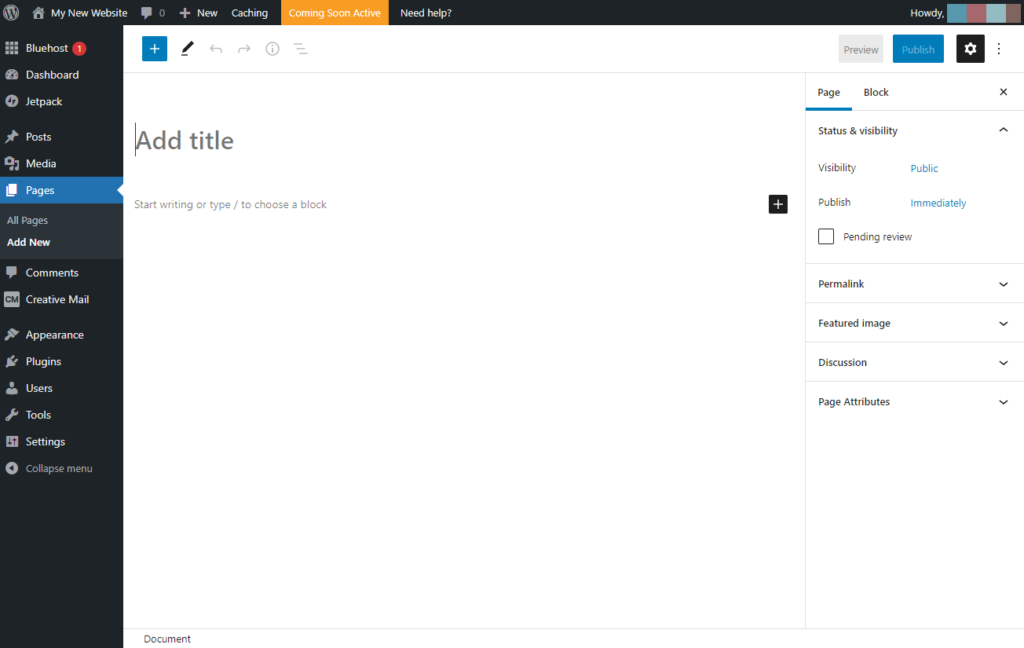
In the Add title box you can create the — you guessed it — title for your home page. This will display a big piece of text at the top. Below that is the content box where you can add text or media.
On the top left, you can click on the + button to add new content blocks.
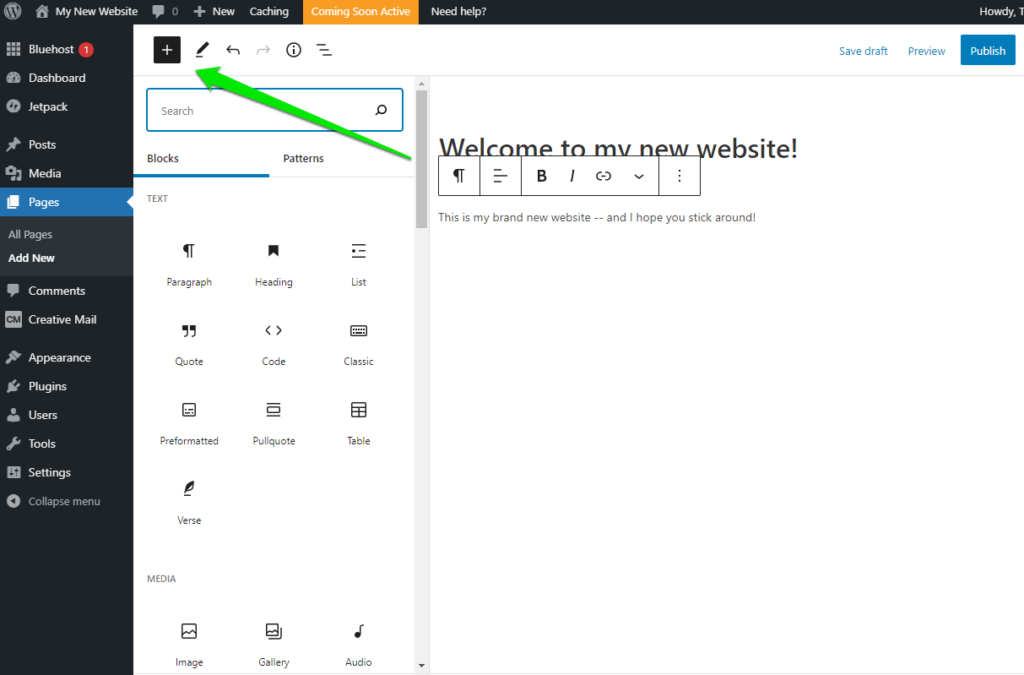
This is a very important area that allows you to easily add media, quotes, pull quotes, new paragraphs, headings, and more.
On the top right, you’ll see five buttons:
- Save Draft. This allows you to save your progress as you edit your homepage.
- Preview. This gives you a look at what your page will look like once you publish it.
- Publish. This actually publishes the draft.
- Settings (Gear Icon). This area allows you to do a number of things including editing the font size for each block (under the Block section). You’ll also be able to set the visibility for your homepage, schedule a time to publish the page, change the URL, set the featured image, and allow for comments (under the Page section).
- Extra tools (Three Dots). This menu includes a number of extra tools you can use to change the visualization of your page editor.
Create a basic homepage now by adding a title and content. It doesn’t need to be fancy. We’re just doing this as a test run. You can always change it later.
Once you’ve done that, click Publish in the top right. The website will now be live!
But that doesn’t mean it’s your homepage yet. Go to Appearance>Customize on the sidebar.

Then go to Homepage Settings. You can now click on A static page underneath your homepage displaying settings. This will allow you to select the homepage you just created in the dropdown menu underneath Homepage.

Select that page, then click on Publish at the top.
Congrats!! You just created your very first homepage.
How to Create New Landing Pages
Creating any other page for your website will consist mostly of the same steps as your homepage.
First, head back to your WordPress website dashboard and click on Pages>Add New.

And in the page editor create the page you want to create. It’s really as simple as that.
If you’re not sure what types of pages to create, here’s some inspiration to get the ball rolling:
- About Us
- Contact Us
- Products
- Webinars
- Videos
- Sign Up
- Customer Stories
- Blog
- Solutions
There are hundreds of different options. The right landing pages for you will largely depend on the type of site you’re creating. For example, if you’re not selling anything, then you won’t need a product page. If you don’t have any customers or case studies, then you won’t need a customer stories page.
Don’t worry about building every single page for your site right now. You can always add more later. Start with three or four, and then come back to this stage another time.
Step 7: Connect Your Web Pages with Menus
Creating menus is going to vary from theme to theme. However, in OceanWP it’s fairly simple.
From your WordPress dashboard, click on Appearance>Customize.

Then click on Menu>Create New Menu.

Here you’ll be able to give your menu a name and choose where you’d like it to appear.
For now, we’re going to go with the very creative name “New Menu” and choose Top Bar for the menu location. You can always change this later. Then click Next.

Now it’s time to add some links. Click on + Add Items to start building your menu.

From here you can add pages via the pages that you have already created, custom links to different websites, blog posts, categories, tags, and more.
For now, we’re going to add our Home, Contact, and About pages (which we created in the previous parts) onto the menu.
Click on the pages under the Pages section to do so.

They will now appear in the top bar menu of your main website.

One thing to note is that you can create drop-down menus for bigger categories you can think of.
For example, let’s say we want to add our Contact page to our About section. You can do so by dragging the Contact menu underneath the About section when customizing the menu (see below).

Your About menu will now include a dropdown where visitors can access your Contact page.

Once you’re finished making the menus, click on Publish at the top.
And you’re done! You just created your very first website.
Check out your new website in all its glory:
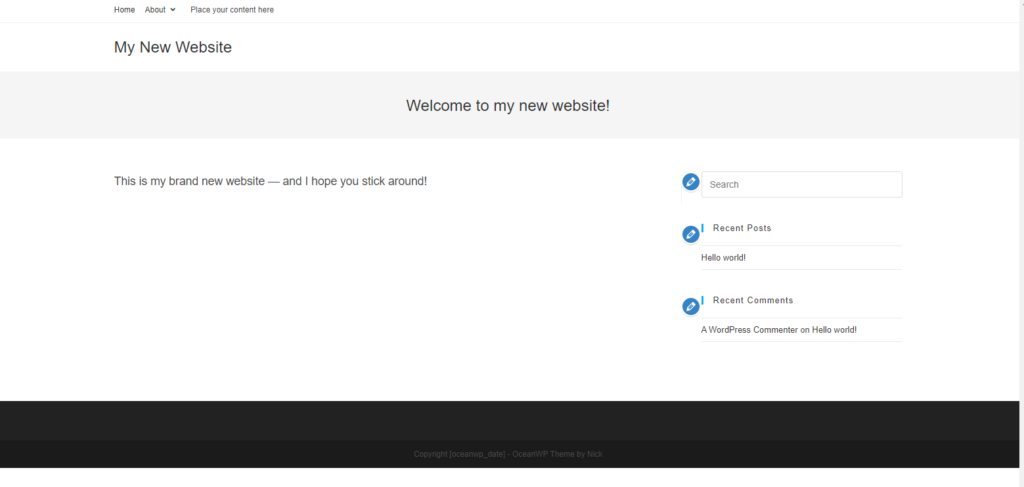
Okay, we admit: It’s a little underwhelming right now—but that’s because you haven’t gone about branding it or adding any real content yet!
We showed you how to get your website up and running. Now it’s YOUR turn to make it with content.
You Just Made Your First Website! What’s Next?
- Best deal for hosting
- AI website builder
- Free domain registration
- Starts at $2.99/month
Congrats on creating your first website! Seriously, you should pat yourself on the back.
Now that you’ve signed up for Hostinger and installed WordPress, there’s still some work to be done once your website is up and running—the journey has just begun.
You’ll still need to tweak and make adjustments to your site regularly to optimize its performance and ensure it’s meeting your audience’s needs. If you want to put your website to work for you and make some extra cash, check out these excellent resources on monetizing your site:
- How to Make Money Blogging
- How to Start a Blog That Makes Money (Lessons Learned)
- How to Make Money from a Website
- When to Use WordPress for Ecommerce and When to Avoid It
All of these guides are beginner-friendly and easy to follow. Enjoy and good luck!

